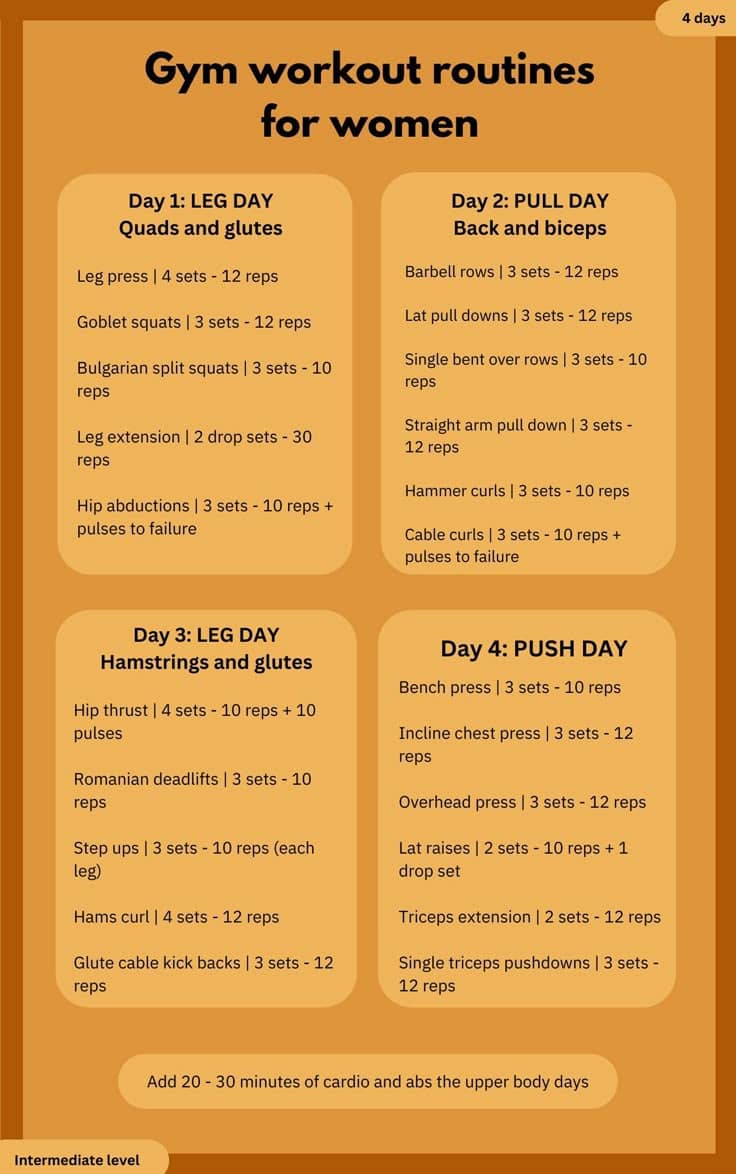A Comprehensive 4-Day Gym Workout Routine for Women: Building Strength, Sculpting Curves, and Boosting Confidence
Are you ready to elevate your fitness journey, tone your entire body, and feel more confident than ever? Look no further than this 4-day gym workout routine for women, designed to target all the major muscle groups while promoting strength, endurance, and a more defined physique. Whether your goal is to enhance lower-body curves, build upper-body strength, or simply achieve a balanced, healthy lifestyle, this intermediate-level plan is a fantastic starting point.
Below, we will walk through a day-by-day breakdown of each workout, including recommended sets, reps, and tips on perfecting your form. We’ll also share insights on progressive overload, rest and recovery, nutrition tips, and cardio—all of which are integral to achieving lasting results.
Table of Contents
- Why a 4-Day Workout Split?
- Safety and Disclaimers
- Essential Warm-Up and Cool Down Routines
- Day 1: Leg Day (Quads and Glutes)
- Day 2: Pull Day (Back and Biceps)
- Day 3: Leg Day (Hamstrings and Glutes)
- Day 4: Push Day (Chest, Shoulders, and Triceps)
- Additional Tips for Success
- Frequently Asked Questions (FAQ)
1. Why a 4-Day Workout Split?
A 4-day workout split is an excellent way to ensure your muscles get targeted work without overtraining. By splitting your training into specialized focus areas, you allow for:
- Sufficient recovery between sessions.
- Variety and balance, ensuring both upper and lower body receive attention.
- Reduced risk of injury, as no single muscle group is overworked on consecutive days.
- Consistency and adherence, helping you stay motivated with structured workouts.
Women often have specific goals such as enhancing glute development, tightening the core, and strengthening the arms. With this program, we place extra emphasis on the legs and glutes—featuring two leg days—while still covering all other major muscle groups. This allows for balanced growth, aesthetic shaping, and improved strength.
2. Safety and Disclaimers
Before diving into any workout program, always remember:
- Consult a healthcare professional if you have underlying health conditions or concerns.
- Listen to your body—never push through severe pain or discomfort. A little muscle soreness is normal, but sharp or acute pain is a warning sign.
- Prioritize good form above all else; proper form not only prevents injury but also maximizes each exercise’s effectiveness.
- Stay hydrated—drink water before, during, and after your workouts.
Your well-being should be the top priority. Combine these workouts with a balanced diet and consider working with a certified personal trainer if you are new to gym equipment or strength training.
3. Essential Warm-Up and Cool Down Routines
Warm-Up
- Light Cardio (5-10 minutes): Start with the treadmill, stationary bike, or elliptical to gradually increase your heart rate.
- Dynamic Stretching (5 minutes): Perform leg swings, arm circles, hip openers, and shoulder rolls to lubricate joints and improve range of motion.
Cool Down
- Gentle Movements (2-5 minutes): Slow walking or cycling to bring heart rate back down.
- Static Stretching (5 minutes): Focus on the major muscle groups you worked. This helps reduce muscle tension and can improve flexibility over time.
Never underestimate the power of an effective warm-up and cool down. They can help minimize soreness, prevent injuries, and optimize your training performance.
4. Day 1: Leg Day (Quads and Glutes)
Leg and glute training is essential for lower-body strength and aesthetics. Strong legs also support overall functionality in daily life, from climbing stairs to lifting heavy objects. Here’s a breakdown of Day 1 exercises:
- Leg Press
- Sets & Reps: 4 sets x 12 reps
- Tips: Keep your feet shoulder-width apart. Push through your heels to engage your quads and glutes effectively.
- Goblet Squats
- Sets & Reps: 3 sets x 12 reps
- Tips: Hold a dumbbell close to your chest. Keep your chest high, spine neutral, and drive through your heels.
- Bulgarian Split Squats
- Sets & Reps: 3 sets x 10 reps per leg
- Tips: Place your back foot on a bench behind you. Focus on stability and balance. Engage your core to maintain an upright posture.
- Leg Extension
- Sets & Reps: 2 drop sets x 30 reps
- Tips: A “drop set” means you start at a heavier weight, do as many reps as you can, then immediately lower the weight and continue to fatigue. This helps boost muscular endurance and growth.
- Hip Abductions
- Sets & Reps: 3 sets x 10 reps + pulses to failure
- Tips: Sit up tall with a neutral spine, keep constant tension on the outer glutes and hips. Pulses at the end of the set target those smaller stabilizing muscles, aiding in shaping and toning the hip area.
Remember, rest for about 60-90 seconds between sets. Keep movements controlled and focus on form over speed.
5. Day 2: Pull Day (Back and Biceps)
A dedicated “pull day” prioritizes exercises that involve pulling motions, targeting the back and biceps. This is crucial for good posture, upper-body balance, and arm strength. Below is the lineup for Day 2:
- Barbell Rows
- Sets & Reps: 3 sets x 12 reps
- Tips: Keep your back neutral. Pull the barbell to your mid-torso, squeezing your shoulder blades together at the top.
- Lat Pull Downs
- Sets & Reps: 3 sets x 12 reps
- Tips: Lean back slightly, pull the bar down to your chest, and avoid using momentum. Focus on the lat muscles.
- Single Bent Over Rows
- Sets & Reps: 3 sets x 10 reps per arm
- Tips: Use a dumbbell. Keep your spine straight and drive your elbow back towards your hip for optimal lat engagement.
- Straight Arm Pull Down
- Sets & Reps: 3 sets x 12 reps
- Tips: Hold the lat pull-down bar or rope attachment with straight arms and pull down from shoulder level to your thighs. This isolates the latissimus dorsi muscle.
- Hammer Curls
- Sets & Reps: 3 sets x 10 reps
- Tips: Keep your elbows close to your torso and palms facing inwards. This exercise targets both the biceps and forearms.
- Cable Curls
- Sets & Reps: 3 sets x 10 reps + pulses to failure
- Tips: Using a cable machine helps maintain constant tension on the biceps. After your standard reps, add small pulses to maximize the burn.
Maintain controlled, steady movements, ensuring the focus remains on the back and biceps rather than momentum. Proper posture is vital to protect the lower back.
6. Day 3: Leg Day (Hamstrings and Glutes)
On Day 3, you’ll once again focus on the lower body—but this time with an emphasis on the hamstrings and glutes. This session complements Day 1’s quad-focused routine, ensuring comprehensive leg development.
- Hip Thrust
- Sets & Reps: 4 sets x 10 reps + 10 pulses
- Tips: Position your upper back on a bench, with your feet on the ground. Drive through your heels, fully extending the hips. The final pulses help engage the glutes further.
- Romanian Deadlifts (RDLs)
- Sets & Reps: 3 sets x 10 reps
- Tips: Keep your knees slightly bent and your back straight. Lower the bar or dumbbells towards your mid-shin, feeling a stretch in your hamstrings before driving back up.
- Step-Ups
- Sets & Reps: 3 sets x 10 reps each leg
- Tips: Choose a box or bench high enough to challenge you but maintain control. Press through the heel of the working leg, bringing your other leg up in a smooth motion.
- Hamstring Curl
- Sets & Reps: 4 sets x 12 reps
- Tips: Use a lying or seated hamstring curl machine. Keep the motion slow and controlled; avoid arching your lower back.
- Glute Cable Kick-Backs
- Sets & Reps: 3 sets x 12 reps per leg
- Tips: Attach the cable around your ankle. Maintain a slight bend in the working leg while keeping your upper body still. Drive your heel back and squeeze the glute at the top.
Again, aim for 60-90 seconds of rest between sets, focusing on technique and mind-muscle connection throughout each movement.
7. Day 4: Push Day (Chest, Shoulders, and Triceps)
Day 4 is dedicated to the “push” muscles: chest, shoulders, and triceps. This day ensures balanced upper-body development and helps sculpt strong, defined arms and shoulders.
- Bench Press
- Sets & Reps: 3 sets x 10 reps
- Tips: Keep your feet planted on the floor, arch your back slightly, and lower the bar (or dumbbells) to your mid-chest.
- Incline Chest Press
- Sets & Reps: 3 sets x 12 reps
- Tips: Adjust the bench to a 30-45-degree incline. This variation targets the upper chest.
- Overhead Press
- Sets & Reps: 3 sets x 12 reps
- Tips: Stand with your feet shoulder-width apart or use a seated position. Press the barbell or dumbbells overhead, bracing your core.
- Lateral Raises
- Sets & Reps: 2 sets x 10 reps + 1 drop set
- Tips: Raise dumbbells to shoulder height with a slight bend in the elbows. Perform a drop set on your last set to fully exhaust the shoulder muscles.
- Triceps Extension
- Sets & Reps: 2 sets x 12 reps
- Tips: You can use a rope attachment on a cable machine or an EZ-bar. Keep elbows tight to your head and extend fully.
- Single Triceps Pushdowns
- Sets & Reps: 3 sets x 12 reps
- Tips: Use a single-handle attachment, focusing on each arm individually. Maintain control and avoid swinging your body.
Additional Cardio and Abs
According to the routine, add 20-30 minutes of cardio on your upper-body days (Days 2 and 4) to improve cardiovascular health and help manage body weight. You can also include an ab circuit of your choice on these days, such as planks, crunches, or hanging leg raises.
8. Additional Tips for Success
A workout plan is only as effective as your ability to stick to it, progress with it, and support it through proper lifestyle habits. Below are core principles to keep in mind.
Progressive Overload
- Gradually increase intensity: Increase the weight, reps, or sets over time. This constant challenge helps your muscles adapt, grow, and become stronger.
- Track your progress: Use a workout journal or app to note your sets, reps, and weights. Progress doesn’t happen overnight, but consistent small improvements lead to major changes.
Nutrition and Hydration
- Balanced diet: Focus on protein sources (chicken, fish, beans), complex carbohydrates (brown rice, oats, quinoa), and healthy fats (avocado, nuts, olive oil).
- Stay hydrated: Water is crucial for muscle function and overall health. Aim for at least eight cups of water a day, or more if you’re sweating heavily.
- Consider your macros: Depending on your goals—fat loss, muscle gain, or maintenance—adjust your caloric intake accordingly. Consulting a nutritionist or dietitian can help you determine the best approach.
Rest and Recovery
- Schedule rest days: Even on non-lifting days, consider light active recovery like stretching, yoga, or walking.
- Get enough sleep: Aim for 7-9 hours of quality sleep each night. Adequate rest helps muscle repair and hormone regulation.
- Foam rolling and massage: Incorporate self-myofascial release to reduce soreness and improve flexibility.
Cardio and Core Training
- Cardio: Low to moderate-intensity cardio 2-3 times per week helps build endurance and support cardiovascular health. If you enjoy high-intensity training, you can also mix in HIIT workouts on separate days.
- Core work: Engaging your abs and lower back is crucial for stability, posture, and form in all exercises. Planks, crunch variations, and leg raises are excellent additions.
9. Frequently Asked Questions (FAQ)
1. How long should each workout session take?
Each session typically lasts 60-90 minutes, depending on rest intervals, warm-up, and additional core or cardio work.
2. Is this routine suitable for beginners?
This plan is best suited for intermediate-level lifters. Beginners could adapt by using lighter weights, fewer sets, and focusing on mastering form. As always, consult a personal trainer for guidance tailored to your fitness level.
3. How can I avoid plateauing?
Implement progressive overload by increasing weights, adjusting rest times, or changing up exercises. Variation keeps your muscles challenged and promotes continuous growth.
4. Can I do cardio every day?
You can do light to moderate-intensity cardio on most days if it doesn’t hinder your recovery. However, high-intensity cardio every day can lead to burnout. Balance is key.
5. What if I miss a workout day?
Life happens, and missing a day occasionally is okay. You can reschedule the workout for the next available day or continue with the normal routine. Consistency over the long term matters more than occasional hiccups.
6. Do I need supplements?
Supplements like whey protein, creatine, and multivitamins can be helpful but are not mandatory. Focus on whole foods first, then consider supplements if you have specific deficiencies or performance goals.
Conclusion
A well-rounded 4-day workout routine for women—featuring two leg days and two upper-body days—provides a strategic balance between strength, toning, and endurance. By targeting quads, hamstrings, glutes, back, biceps, chest, shoulders, and triceps, you can systematically build muscle, improve posture, and boost overall athleticism. Remember to implement progressive overload, eat a nutrient-dense diet, stay hydrated, and give your body adequate rest.
With patience and consistency, you’ll see impressive changes in your physique, confidence, and daily energy levels. Keep track of your progress, celebrate small wins, and continually refine your technique. Before long, you’ll notice not just a stronger, shapelier body but also a healthier mindset ready to conquer any challenge, inside or outside the gym.
Disclaimer: This article is for informational purposes only and does not substitute for professional medical advice. Always consult your doctor before starting any fitness program. By following these tips, you’ll help ensure your progress is steady, safe, and in line with a sustainable, lifelong approach to fitness.
Boost your strength, define your shape, and feel unstoppable with this 4-day workout routine. For more tips on women’s fitness, nutrition, and motivation, stay tuned to our blog—and remember that every day is another chance to grow stronger, inside and out.










